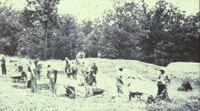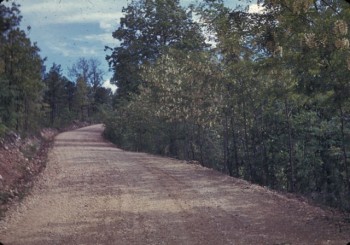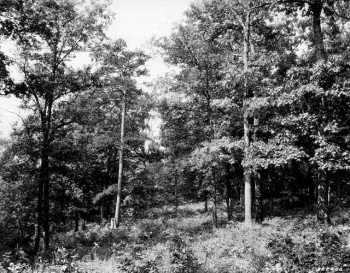Archaeology and Cultural Resources

Mark Twain National Forest, as we know it today, was created on February 17, 1976. The Forest has a rather unique history – for it was once known as both Clark National Forest and Mark Twain National Forest – both being proclaimed on September 11, 1939.
Today, Mark Twain National Forest is the only national forest in Missouri and consists of 1.5 million acres in checkered across a footprint about3 million acres in size. Most of the Forest lies within the Ozark Highlands, located across southern Missouri and northern Arkansas. This geographic area maintains an ancient landscape characterized by large permanent springs, over 5,000 caves, rocky barren glades, old volcanic mountains, and nationally recognized streams. Portions of the Ozarks were never under oceans and glaciers never pushed through them. Native Americans lived in this area for thousands of years before European settlers arrived. Although the terrain could be rough for farming for the pioneers, this country attracted settlers who wanted to utilize the natural resources during the nation’s westward expansion.
Historical Documents from our Library
We are making some of the historical documents about the Mark Twain National Forest available. Note: Most of these documents require retyping and scanning before compiling in a electronic format. We are currently making document available in PDF, EPUB, and MOBI Formats.
- Goins Cabin History
- General History, Mark Twain National Forest
- Memoirs of Ray E. Wehmeier
- Mark Twain National Forest Proclamation
- Clark National Forest
In the 1870s

Citizens of southern Missouri began an era of extensive logging of the state's native oak, hickory, and pine forests. Lumber mills were commonplace, but by the 1920s they had disappeared, along with much of the state's native forests. In the late 1920's and early 1930's, the people of the state became concerned about the condition of idle and sometimes abandoned lands in the Ozarks region.
Much land within the present National Forest boundary had been stripped of timber, burned, and over used as pasture or tilled until its productivity was seriously impaired. Abandoned lands contributed nothing to the local economy or tax base. Erosion was a serious problem and many acres needed rehabilitation.
Much land within the present National Forest boundary had been stripped of timber, burned, and over used as pasture or tilled until its productivity was seriously impaired. Abandoned lands contributed nothing to the local economy or tax base. Erosion was a serious problem and many acres needed rehabilitation.
Establishing the Mark Twain
So, during 1934 and 1935, eight separate purchase units embracing 3,313,705 acres, were established in 28 counties. In 1939, the President of the United States proclaimed four of the eight purchase units as the Mark Twain National Forest. The purchase units involved were: Gasconade (Rolla, Houston), Pond Fork (Ava) Table Rock (Cassville), and Gardner (Willow Springs).
On the same date, the Clark National Forest was established by Proclamation. The units involved were: Clark (Potosi, Salem); Fristoe (Winona, Doniphan, Van Buren), LaMotte (Fredericktown), and Wappapello Lake (Poplar Bluff).
Caves and Karsts

Today, the Mark Twain is host to more than 500 caves. Caves provide habitat for unique animals like cave salamanders and southern cave fish. Shut-in creeks, whose enormous rock boulders restrict flow, create nationally renowned white-water kayaking and canoeing opportunities.
Due to the karst topography, there is an abundance of natural springs found in the area. The Ozarks are home to the world’s largest collection of “first magnitude” springs (those with over 65 million gallons of water daily flow). Almost 3,000 springs feed rivers and streams that flow year-round. Many of these streams are so clear that ten feet of depth appears to be only one foot deep.
Greer Spring, the second largest in Missouri, is considered to be the most pristine and scenic in the state. Discharging an average of 222 million gallons of water per day, Greer Spring more than doubles the flow of the Eleven Point River. The importance of the water resource of the Mark Twain is exemplified by the designation of the Eleven Point Wild and Scenic River, one of the first Wild and Scenic Rivers in the nation. These natural features are a destination for many visitors to Missouri.
Underneath the land surface lays one of the largest lead ore deposits in the world, the Viburnum Trend. Since mining began, more than 250 million tons of economically valuable ore have been recovered, including lead, zinc, and copper. During the last five years the significant economic benefits mining has been reduced by this market-driven industry.
Over 45 million people are within a day's drive of Mark Twain’s unique features and recreation opportunities.

The Naming of the Mark Twain National Forest
(Excerpts taken from Kay Hively’s, “The Naming of a Forest”)

In 1934 the Department of Agriculture began purchasing forest tracts in Missouri as part of the federal government’s plan to restore the wasted timber, manage the overgrazed meadows, control and manage the forest streams, and restore the vanishing wildlife.
As the acreage bought by the Department of Agriculture grew and as restoration began making headway, (thanks primarily to the civilian conservation corps it became evident that the federal forest land in Missouri would need to be officially divided into two national forests.
That sounded like a simple matter, except everyone wanted to name the forests. In 1937 a lot of controversy surrounding the naming of the two forests began to stir up.
As Purchase Units (the forested tracts) they were called “Clark” and “Gardener.” As the time neared to create two National Forests, officials at the Purchase Units were asked to submit names for consideration. The Clark Unit only submitted one name, “Clark” while controversy over the naming of the purchase unit at the “Gardener” unit, led to officials submitting six names.
Leslie S. Bean, Deputy Regional Forester, in the Milwaukee regional office wrote to each unit on September 30, 1937, stating that Clark would be fine for that unit “but we believe further consideration should be given to the name of the Gardner Purchase Unit. However, the history of each name prepared should be given in considerable detail.”
Apparently, officials at Clark weren’t merely satisfied at naming their own unit, they wanted in on naming the other unit as well!
Mozark National Forest?

Paul D. Kelleter (Forest Supervisor at Clark) wrote Mr. Bean on October 1, 1937 with some suggestions. He wrote, “If names of men of recent nation-wide reputation are to be given consideration, Missouri can point with pride to Mark Twain and Eugene Field. It should also be remembered that Audubon played an important part in Missouri, living both in St. Genevieve and St. Louis, and getting the inspiration for considerable of his drawings, books, and plats in this state.” He went on to suggest, Livingston (who played a role in the Louisiana Purchase), and Captain Stoddard (first governor of the Louisiana territory.)
On October 6, 1937, James N. Diehl (Gardner Unit Forest Supervisor) fired a letter off to Milwaukee with his own ideas. In his letter he mentioned the 8 names that had been submitted since 1935 (Shepherd of the Hills, Kikapoo, Osage, Daniel Boone, Mark Twain, Pulaski, Linnaeus and Chickamaugua National Forest.)
Mr. Diehl, added some more names: 1) Glades National Forest – because of the unique topographical features of the Pond Fork and Table Rock Unit where rock out cropping’s resulted in glades or balds. 2) Ridge top NF – because of the oak ridges. 3) Mozark National Forest – combining the names Missouri and Ozarks.
Mr. Kelleter, of the Clark Unit, got back to the act on October 29th (Yes! They were going back and forth with the name of the forest.) and wrote a very well “thought out” letter on why it should be named the Mark Twain.
Washington Office Steps In
Mr. Diehl got back to work and garnered support from local politicians and influential that the name should be Pershings National Forest after Missouri General John J. Pershing. However, after learning that a state park was considering the same name he wrote, “The last legislature voted to establish a Pershing State Park in Linn County to include the site of the birthplace of General Pershings. There should be no conflict between the park and forest…” Then he stated near the end of his letter, “The most prominent and best-known Missourian of all time is Mark Twain.

When a University of Missouri professor, Conrad Hammar, had heard about the suggestion of Pershing as a name he wrote to Mr. Diehl against the idea for three reasons 1)the state park 2) Pershing is not dead 3)there was little in the name that would attract it as a recreational or geographical standpoint. He started suggesting his own names.
The struggle for the name continued until December of 1938 when the Washington Office for the Forest Service proposed that the two MO forests be named, “Mark Twain” and Pershing.” John Hatcher (Acting Chief for the division of national forest, planning and establishment) wrote that he did not want the name “Clark” to be confused with any political interpretation because apparently a man named Clark was running for a political office in Missouri at the time. In January of ’39 the regional forester (a native of Poplar Bluff, MO), Lyle Watts, wrote back to the Washington Office proposing “Pershing’ and “Champ Clark” be the forest names. By adding champ it would take out the political overtones.
In March of ’39 the Washington Office wrote back stating that “Clark National Forest would be the name since the name of Clark also has been important in Missouri in other respects.” Pershing National forest had failed approval in Washington because it was believed that some geographic or hydrographic feature would be more appropriate.
And the Finalists Are... Mozark, Pershing and Mark Twain
The Regional Forester was not pleased and gave a final suggestion of Mozark National Forest.
On September 15, 1939 Forrest T. Hoyt (Acting Chief, Division of Forest Land Planning,) informed Milwaukee Regional Office of Franklin Roosevelt’s action of signing the proclamation establishing the Mark Twain National Forest on September 11, 1939. And so after four years of discussion, the subject had finally been closed and Missouri’s most famous citizen was honored with a National Forest. Ironically, Mark Twain was one of the original suggestions back in 1935 when the National Forest designation was first proposed.
In June 1973 the Clark and Mark Twain NF were brought under one headquarters in Rolla and became known as the National forests in Missouri. On Feb. 17, 1976, the forests were combined and renamed the Mark Twain National Forest.
There were at least 32 names proposed for the old Gardner Purchase Unit.



